

Environment and Social Innovation: Why Technology Never Was the Solution. Chapter First Online: 03 August 2019 Part of the Creative Economy book series (CRE) Abstract For environmental protection, innovation in products and processes is often seen as the ideal solution.
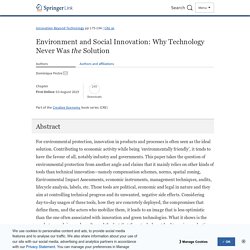
What next for digital social innovation? Realising the potential of people and technology to tackle social challenges. This report, and accompanying guide, produced as part of the DSI4EU project, maps the projects and organisations using technology to tackle social challenges across Europe, and explores the barriers to the growth of digital social innovation.
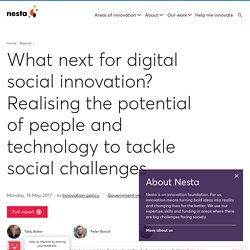
Key findings There are almost 2,000 organisations and over 1,000 projects involved in digital social innovation (DSI) across Europe, with the highest concentration of activity in Western and Southern Europe.Despite this activity, there are relatively few examples of DSI initiatives delivering impact at scale. The growth of DSI is being held back by barriers at the system level and at the level of individual projects. Digital Earth Challenges and Future Trends. 26.2.1 Big Data Management in Digital Earth In discussing the challenges highlighted in earlier chapters of this manual, the authors have demonstrated the tremendous volume, variety, veracity, and velocity (the four Vs) challenges for Big Earth Data (Guo et al. 2017; Yang et al. 2017).
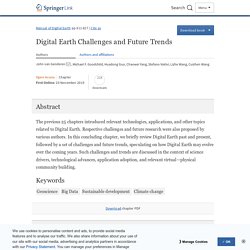
The four Vs impose new requirements on computing, data management, information extraction, and knowledge discovery, as well as the detection of events of interest, needed to realize the value (the fifth V) of Big Earth Data for Earth science and applications (Guo et al. 2014; Lee and Kang 2015; Shu 2016;Yang et al. 2019). According to Filchev et al. (2018), up to 95% of the Earth observation (EO) data present in existing archives has never been accessed, so the potential for increasing exploitation is very large.
Many satellite agencies are now changing their data archive holdings to cloud-based or hybrid storage. 26.2.2 Large-Scale Digital Earth Platform Implementation and Construction. Experts Predict More Digital Innovation by 2030 Aimed at Enhancing Democracy. This is the 11th “Future of the Internet” canvassing Pew Research Center and the Imagining the Internet Center have conducted together to get expert views about important digital issues.
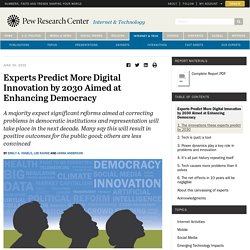
In this case the questions focused on the future of democracy, the problems digital technology has created and possible solutions to those problems. This is a nonscientific canvassing based on a non-random sample, so the results represent only the individuals who responded to the query and are not projectable to any other population. Addressing socio-ecological development challenges in the digital age: Exploring the potential of Environmental Virtual Observatories for Connective Action (EVOCA) Agrawal, 2001 A.
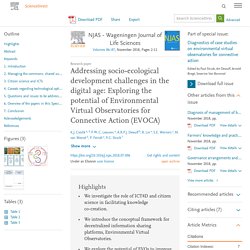
AgrawalCommon property institutions and sustainable governance of resources World Dev., 29 (10) (2001), pp. 1649-1672. Sad Facts on Technotrash — Digital Responsibility. Digital inequalities 3.0: Emergent inequalities in the information age. -JST Joint Call on Artificial Intelligence and Society - Arts and Humanities Research Council. 14615517.2019. In the beginning Social impact assessment (SIA) began in the 1970s alongside the rise of Environmental Impact Assessment (EIA) (Esteves et al. 2012Esteves AM, Franks D, Vanclay F. 2012.
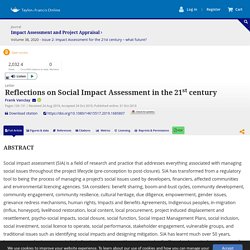
Social Impact Assessment: the state of the art. Imp Assess Proj Apprais. 30(1):35–44. [Taylor & Francis Online], [Web of Science ®], [Google Scholar]; Vanclay 2014Vanclay F. 2014. Using crowdsourced imagery to detect cultural ecosystem services: a case study in South Wales, UK. Copyright © 2016 by the author(s).
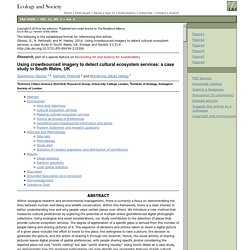
Published here under license by The Resilience Alliance. Go to the pdf version of this article The following is the established format for referencing this article: Gliozzo, G., N. Pettorelli, and M. Haklay. 2016. MapWithAI. For 15 years, thousands of volunteers have used the online platform OpenStreetMap (OSM) to create an open map of the world.
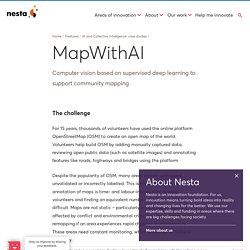
Volunteers help build OSM by adding manually captured data, reviewing open public data (such as satellite images) and annotating features like roads, highways and bridges using the platform. Despite the popularity of OSM, many areas remain unmapped, unvalidated or incorrectly labelled. This is mostly because crowd annotation of maps is time- and labour-intensive for remote volunteers and finding an equivalent number of real-life validators is difficult. Maps are not static – particularly in vulnerable regions affected by conflict and environmental crises – so they may require remapping if an area experiences rapid changes in infrastructure. These areas need constant monitoring, which is difficult to achieve manually.
MapWithAI uses computer vision to detect roads and terrain features of the streets on high-resolution satellite imagery. Collective Intelligence Grants 2.0. In September 2019, we launched the second round of the Collective Intelligence Grants in partnership with Wellcome Trust, Cloudera Foundation, and Omidyar Network.
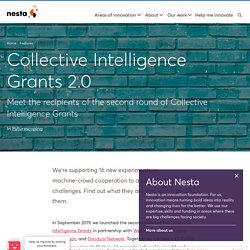
Together we created a £500,000 fund for experiments that could generate actionable insight on how to advance collective intelligence to solve social problems. Find out how our second cohort of grantees is using new digital technologies and collective intelligence methods to address issues ranging from air pollution to food shortages, disease diagnosis and cyber violence. Exploring AI-crowd interaction At the Centre for Collective Intelligence Design, we believe that to tackle complex problems we need to mobilise all the resources of intelligence available to us. Citizen science in hydrological monitoring and ecosystem services management: State of the art and future prospects.
Abbott et al., 2018 B.W.
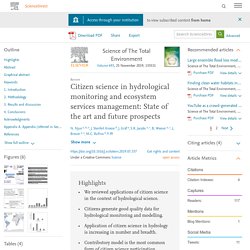
Abbott, F. Moatar, O. The GROW Observatory – The GROW Observatory. GROW Summary Report. Public access to spatial data on private-land conservation. Copyright © 2017 by the author(s). Published here under license by The Resilience Alliance. This article is under a Creative Commons Attribution-NonCommercial 4.0 International License. You may share and adapt the work for noncommercial purposes provided the original author and source are credited, you indicate whether any changes were made, and you include a link to the license. Go to the pdf version of this article. Jrc117665 jrc117665 ws cs and env monitorng final draft report for e publication. Citizens Science and Environmental Monitoring: Benefits and Challenges. Citizen Social Science for More Integrative and Effective Climate Action: A Science-Policy Perspective. Introduction This paper examines why current forms of climate policy are not working and offers some suggestions as to how to further increase citizen engagement in science and policy decisions at different scales of governance that move beyond tokenistic forms of citizen participation.
We offer a framework for what we call “citizen social science” (CSS), highlighting the various social, political and institutional barriers that prevent greater citizen participation in climate science and policy decisions. We then present some suggestions as to how CSS can potentially be used to overcome these barriers to enable citizens to contribute more effectively and directly to ambitious formal climate policy goals.
Citizen Participatory Issues With Current Forms of Climate Policy-Making National governments make top-down climate policy decisions that often involve little input from lay citizens. Elevating Citizen Engagement Citizen Social Science: Moving Beyond Citizen Science. 09640568.2018. Citizen science projects are increasingly recognised as catalyst for triggering behaviour change and building social capital around environmental issues. However, overview studies observe recurrent challenges in many citizen science projects in terms of combining high levels of data quality with deep citizen engagement and policy influence.
This paper reports on the findings of the CurieuzeNeuzen project (www.CurieuzeNeuzen.eu), a large-scale citizen science project on air quality in Antwerp, delivering results in the three areas described above. Re-calibrating DIY: Testing digital participation across dust sensors, fry pans and environmental pollution - Helen Pritchard, Jennifer Gabrys, Lara Houston, 2018. Introduction. The Society for Conservation Biology. Many argue that monitoring conducted exclusively by scientists is insufficient to address ongoing environmental challenges. Poster eleanor starkey 2 feasibility reliability citizen science. The Society for Conservation Biology. Behavior Change For Nature: A Behavioral Science Toolkit for Practitioners. Digital Sustainability and Entrepreneurship: How Digital Innovations Are Helping Tackle Climate Change and Sustainable Development.
Ijerph 17 01355. How Digital Leadership Is(n’t) Different. Either way you look at it, as organizations seek their footing in a turbulent business environment, they require strong leaders at the helm. Senior leaders must not only articulate a vision people can rally around but also create the conditions that enable digital maturity, attracting the best talent and bringing out the best in the talent they attract. Understanding digital transformation: A review and a research agenda. Five Rules for Leading in a Digital World. Topics (Re)Learn to Lead (Re)Learn to Lead is a limited article series that distills wisdom from prominent experts on the future of leadership in a changing world. The Role of Leadership in a Digitalized World: A Review. Introduction. ED577567 - Developing Appropriate Workforce Skills for Australia's Emerging Digital Economy: Working Paper, National Centre for Vocational Education Research (NCVER), 2017. Impact assessment for the 21st century what future.
1SESAofAutomation fullscopingfin201905. International Institute for Sustainable Development. National Data Strategy. Viewpoint: Emerging Digital Technologies: A Sinister Presage for Privacy? by Dr. Catriona Planel-Ratna.